BOMANN EHBC 560.1 Operating instructions
- Category
- Kitchen & houseware accessories
- Type
- Operating instructions
This manual is also suitable for
BOMANN EHBC 560.1 is a multifunctional electric oven set that combines a ceramic hob with a spacious oven, offering various cooking options for your culinary creations. The ceramic hob features four heating zones with different power levels, providing efficient and precise heat distribution for your pots and pans. The oven, with its 56-liter capacity, allows you to cook large meals or bake delicious pastries, utilizing its diverse functions such as top and bottom heat, grill, and convection.
BOMANN EHBC 560.1 is a multifunctional electric oven set that combines a ceramic hob with a spacious oven, offering various cooking options for your culinary creations. The ceramic hob features four heating zones with different power levels, providing efficient and precise heat distribution for your pots and pans. The oven, with its 56-liter capacity, allows you to cook large meals or bake delicious pastries, utilizing its diverse functions such as top and bottom heat, grill, and convection.




















-
 1
1
-
 2
2
-
 3
3
-
 4
4
-
 5
5
-
 6
6
-
 7
7
-
 8
8
-
 9
9
-
 10
10
-
 11
11
-
 12
12
-
 13
13
-
 14
14
-
 15
15
-
 16
16
-
 17
17
-
 18
18
-
 19
19
-
 20
20
BOMANN EHBC 560.1 Operating instructions
- Category
- Kitchen & houseware accessories
- Type
- Operating instructions
- This manual is also suitable for
BOMANN EHBC 560.1 is a multifunctional electric oven set that combines a ceramic hob with a spacious oven, offering various cooking options for your culinary creations. The ceramic hob features four heating zones with different power levels, providing efficient and precise heat distribution for your pots and pans. The oven, with its 56-liter capacity, allows you to cook large meals or bake delicious pastries, utilizing its diverse functions such as top and bottom heat, grill, and convection.
Ask a question and I''ll find the answer in the document
Finding information in a document is now easier with AI
Related papers
-
BOMANN EHBC 560.1 Operating instructions
-
BOMANN EH 561 Operating instructions
-
BOMANN EHBC 562.1 Operating instructions
-
BOMANN EH 561 Operating instructions
-
BOMANN EBO 9612.1 Operating instructions
-
BOMANN EBO 9612.1 Operating instructions
-
BOMANN EHBC 559 Operating instructions
-
BOMANN EHBC 562.1 Operating instructions
-
BOMANN EBO 7900 IX Owner's manual
-
BOMANN EHBC 557 IX User manual
Other documents
-
Samsung CTN464EB Series User manual
-
SEVERIN RG 2619 Datasheet
-
Bertazzoni KIN30XT Installation guide
-
SEVERIN RG2682 Datasheet
-
 Euro Appliances EV900EESX User manual
Euro Appliances EV900EESX User manual
-
Bosch HQA050020Q/07 User guide
-
Bosch HLS59G020U/01 User guide
-
Bosch HLS59E050U/02 User guide
-
Siemens HL9S5E020U/09 User manual
-
Siemens Electric free-standing cooker Operating instructions




















